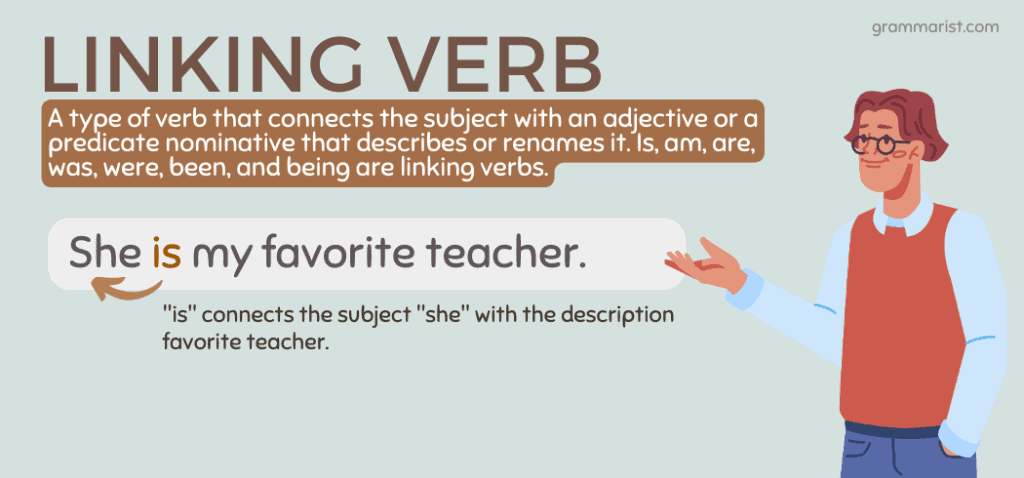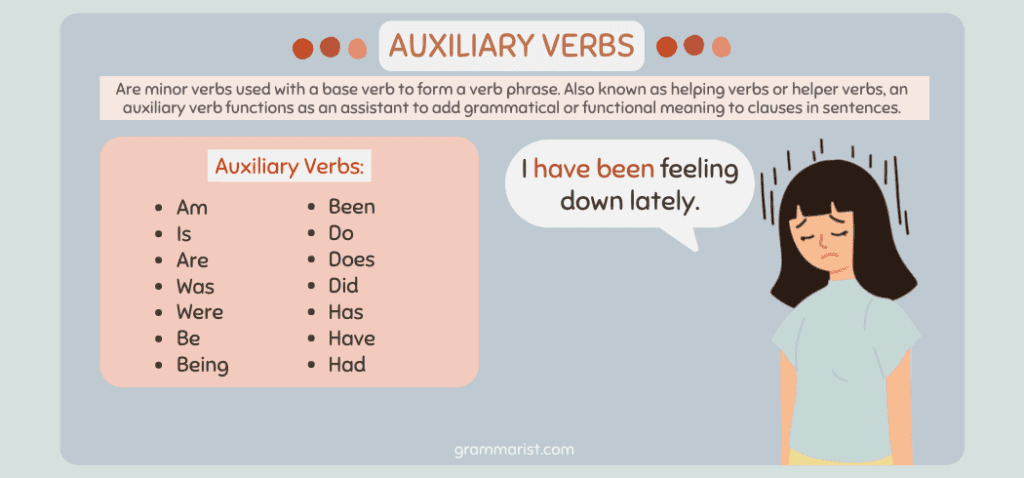You might already know that verbs express actions, states of being, or conditions. But what is the difference between a linking verb and a helping verb?
A linking verb is a type of verb used to connect subjects and predicates, while a helping verb assists the main verb in completing the sentence. This guide will thoroughly explain the difference between the two verbs to you!
Difference Between Linking and Helping Verbs
The difference between linking and helping verbs is based on their function in the sentence.
What Is a Linking Verb?

A linking verb or copular verb is a type of verb that connects the subject with an adjective or a predicate nominative that describes or renames it. Some verbs of this kind include seem, look, sound, become, and taste, which are all sense verbs.
The most common linking verb is the basic form of to be and all of its forms. Is, am, are, was, were, been, and being are linking verbs.
Here are some examples.
- She is my favorite teacher.
- This perfume smells nice.
- Moira feels sick today.
In the first sentence, is connects the subject she with the description favorite teacher. The same pattern can be observed in the second and third sentences.
Note that smell, feel, and other verbs can also act as action verbs in some sentences. But as linking verbs, they only show a state of being. Take a look at this example.
- Action verb: I can smell the cookies you’re baking.
- Linking verb: You smell good.
In the first sentence, the action verb smell shows the action of perceiving the scent of something. But in the second sentence, smell as a linking verb shows a state of being.
What Is a Helping Verb?

Helping or auxiliary verbs are exactly how they sound. They “help” another main verb or principal verb and the rest of the sentence by expressing time or giving other information. The three main helping verbs in the English language are be, do, and have.
Here are some examples of helping verbs in sentences.
- She does love cooking.
- I am watching a new show tonight.
- Do you like books?
Most helping verbs work to show the complete verb form of a specific tense, such as the present progressive tense.
- My family is sleeping.
- I have seen this picture before.
In the first sentence, is sleeping is an action verb phrase in the present progressive tense. The main verb sleeping cannot stand on its own without the helping verb is. In the second sentence, the action verb phrase is have seen.
We use the helping verb do to emphasize the main verb or produce a sentence in question form. Here are some examples.
- My mother does enjoy listening to classical music.
- Do you eat tacos?
The action verb phrase in the first sentence is does enjoy, while the action verb phrase in the second one is do eat.
Modal verbs are also helping verbs. A modal verb is used alongside another verb to express possibility, obligation, capability, and permission. Some examples include can, may, must, should, would, and might. For example:
- We might eat dinner with our grandparents later.
- I could ride a bicycle when I was young.
In the first sentence, the modal verb might from the action verb phrase might eat expresses the likelihood of eating dinner with grandparents. The modal verb could in the second sentence expresses a past capability of riding a possibility when the speaker was young.
We also use modal verbs to offer something and ask questions. For example:
- Would you like some water?
- Will you please open the door?
Linking Verb List
- Is
- Am
- Are
- Was
- Were
- Be
- Been
- Being
- Appear
- Become
- Feel
- Grow
- Look
- Remain
- Seem
- Smell
- Sound
- Stay
- Taste
- Turn
- Prove
- Can be
- Could be
- Had been
- Has been
- Have been
- May be
- Might be
- Might have been
Helping Verb List
- Is
- Am
- Are
- Was
- Were
- Be
- Been
- Being
- Has
- Had
- Have
- Does
- Do
- Did
- Will
- Can
- Could
- Shall
- Should
- Would
- Must
- May
- Might
Linking Verbs That Can Be Helping Verbs
- Is
- Am
- Are
- Was
- Were
- Be
- Been
- Being
What Is a Linking Verb Phrase?
A linking verb phrase is a group of linking verbs that connect the subject with an adjective or a predicate nominative. For example:
- She has been the CEO of the organization since 2013.
- There may be a price increase on gasoline next week.
So, Are Linking Verbs and Helping Verbs the Same?
Understanding verbs allows us to know their functions in sentences. Some express actions, others add tense, while a few express a condition or state of being.
This guide has taught you that linking verbs connect subjects and predicates and do not express action, while helping verbs assist main verbs in showing tense or adding extra information.
